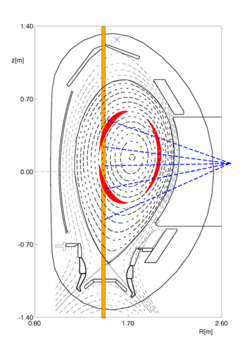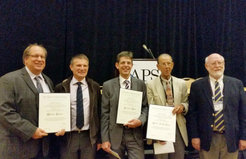John Dawson Award 2014 – distinction for IPP scientist
Prize awarded by the American Physical Society to Prof. Hartmut Zohm / plasma perturbation dissolved

For outstanding achievements in Plasma Physics the American Physical Society (APS) has made the John Dawson Award 2014 to Prof. Dr. Hartmut Zohm from Max Planck Institute for Plasma Physics (IPP) in Garching. This distinction was for his theoretical prediction and subsequent experimental demonstration that a particularly undesirable perturbation in the plasma, the Neoclassical Tearing Modes, can be stabilised by microwaves. The objective of fusion research is a power plant that, like the sun, derives energy from fusion of atomic nuclei.
The award, endowed with 5,000 US dollars, is shared with four other fusion physicists: Prof. James D. Callen and Prof. Chris Hegna from the University of Wisconsin, Dr. Robert J. La Haye from General Atomics, USA, and Dr. Olivier Sauter from Ecole Polytechnique Fédérale de Lausanne, Switzerland. The prize was presented to the five scientists last week in New Orleans at the annual meeting of the APS Section for Plasma Physics.

To ignite the fusion fire, the fuel, viz. a hydrogen plasma, has to be confined and kept stable in magnetic fields and then heated to temperatures of over 100 million degrees. Neoclassical Tearing Modes are blister-like perturbations in the otherwise symmetric plasma ring. Their existence was predicted in 1990 by prize winner James Callen; in 1994 they were identified in three devices in Germany and the USA. These magnetic islands are triggered by the rise of the plasma pressure at high plasma temperature. The emergence of the islands tears up the magnetic field lines, which then link up with the field lines of neighbouring magnetic surfaces. This culminates quasi in magnetic short-circuiting. As fast energy exchange transverse to the surfaces is now made possible, the plasma temperature and pressure sharply drop over the breadth of the island. The tearing modes thus impose a limit on the plasma pressure attainable; Olivier Sauter recognised that the energy yield of ITER and a future reactor would thus be severely impaired.
As the upper limit of the plasma pressure is the lower the larger the devices are, the tearing modes in a power plant were at first seemingly inevitable. All the greater was the excitement when the Hartmut Zohm team at Garching’s ASDEX Upgrade succeeded in 1999 for the first time in preventing the formation of these magnetic islands. Two years previously, Chris Hegna and Jim Callen and, independently of them, Hartmut Zohm had theoretically developed the method: injection of microwaves into the centre of an emerging island – with centimetre precision. This locally generates an electric current that dissolves the island. The magnetic field perturbation is thus suppressed and the plasma pressure can rise again. Soon after, similar experiments headed by Robert La Haye were also conducted on the DIII-D device in the USA. Here tearing modes, which can lead to complete less of the plasma discharge, were suppressed.
Meanwhile, an automatic feedback control can independently identify the islands in the plasma, sight them with moving mirrors, and trigger the microwave beam. Also the ITER plans already envisage for this purpose controllable coupling in of the microwaves.
Isabella Milch

